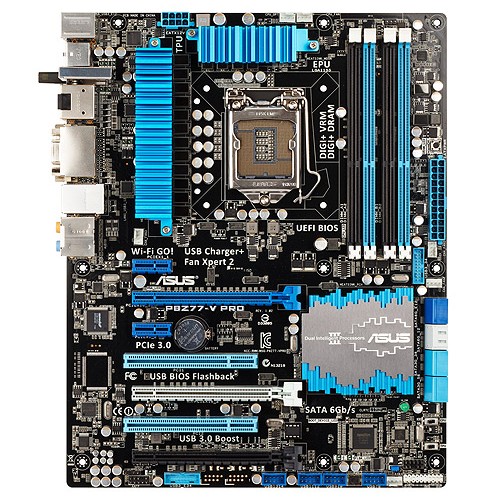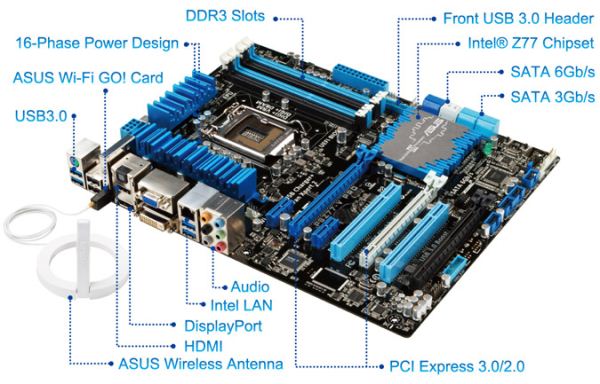Intel Z77 Panther Point Chipset and Motherboard Preview – ASRock, ASUS, Gigabyte, MSI, ECS and Biostar
by Ian Cutress on April 8, 2012 12:00 AM EST- Posted in
- Motherboards
- Intel
- Biostar
- MSI
- Gigabyte
- ASRock
- Asus
- Ivy Bridge
- ECS
- Z77
ASUS P8Z77-V Pro—Visual Inspection
ASUS have a lot to live up to with its Ivy Bridge Pro board. Both the ASUS P8P67 Pro and ASUS P8Z68-V Pro have been top class sellers in their respective chipsets, meaning that ASUS has to deliver. Thankfully, by just looking at the board, it seems that ASUS is keen to innovate and offer a complete package.
Using a 12 + 4 VRM power delivery system, the ASUS P8Z77-V Pro sports a blue and black livery synonymous with their channel / non-ROG products. The VRM heatsinks cover a lot of surface area in their jagged fashion, and around the socket itself, we have access to five main fan headers. Two of these are CPU 4-pin headers just north of the top VRM heatsink, one 4-pin below the left hand side VRM heatsink, and two 4-pin headers below the 24-pin ATX power connector, along with a USB 3.0 port. A sixth fan header (4-pin) is found on the south side of the board.

Above the 24-pin ATX power connector, we find the ASUS MemOK! button, which allows memory recovery to default speeds. Along with the ASRock boards, we have eight SATA ports—four SATA 3 Gbps from the PCH and four SATA 6 Gbps—two from the PCH and two more from an ASMedia controller. Below this are the TPU and EPU switches, designed for enhanced CPU performance and energy saving modes respectively.

Along the bottom of the board is the standard array of a front panel audio header, another USB 3.0 header, USB 2.0 headers, and a front panel header. In terms of PCIe layout, despite there being three full-length PCIe connectors on board, we are only limited to using two for multi-GPU setups. In order, we have a PCIe x1, a PCIe 3.0 x16 (x8 in dual GPU), x1, PCI, PCIe 3.0 x8, PCI, and a PCIe 2.0 x4. Thus in dual GPU mode, similarly to the ASRock Extreme6, we can also add in a PCIe x1 and PCIe x4 card.
The chipset heatsink is indicative of the large but low philosophy of many motherboard manufacturers, hiding away the chipset controller. What is not on these boards, as you may notice, is a combination power/reset pair of buttons, nor a two-digit debug, some of which we used to see on ASUS Pro boards of old. Nevertheless, the ASUS board in return makes up for it on the back IO panel.

On the back panel, we have a combination PS/2 port, two USB 3.0 ports (blue), two USB 2.0 ports (black), an ASUS Wi-Fi GO! Card, optical SPDIF output, HDMI, DisplayPort, D-Sub, DVI-D, gigabit Ethernet, two more USB 3.0 ports in blue, and standard audio headers.
This means that rather than add in a WiFi module on the board, or use up a mini-PCIe slot with wifi, we have a slot in order to add a WiFi module. This can be in 2.4 GHz or 5 GHz mode, and updateable as WiFi standards change. This all comes as part of the package, with magnetic wireless antenna to attach to the case.
Board Features
| ASUS P8Z77-V Pro | |
| Size | ATX |
| CPU Interface | LGA-1155 |
| Chipset | Intel Z77 |
| Power Delivery | 12 + 4 |
| Memory Slots |
Four DDR3 DIMM slots supporting up to 32 GB Up to Dual Channel |
| Video Outputs | DisplayPort, HDMI 1.4a, DVI-D, D-Sub |
| Onboard LAN | Intel 82579V |
| Onboard Audio | Realtek ALC892 |
| Expansion Slots |
2 x PCIe x16 Gen3 (x16, x8/8) 1 x PCIe x16 Gen2 (x4) 2 x PCIe x1 Gen2 2 x PCI |
| Onboard SATA/RAID |
2 x SATA 6 Gbps (PCH), Support for RAID 0, 1, 5, 10 2 x SATA 6 Gbps (ASMedia) 4 x SATA 3 Gbps (PCH), Support for RAID 0, 1, 5, 10 |
| USB |
Four USB 3.0 at rear (2 PCH, 2 ASMedia) Two USB 3.0 headers on board (PCH, ASMedia) Ten USB 2.0 (2 back panel, 8 on board) |
| Onboard |
4 x SATA 6 Gbps 4 x SATA 3 Gbps 2 x USB 3.0 Headers 4 x USB 2.0 Headers 6 x Fan Headers 1 x SPDIF Header 1 x Front Panel Audio Header MemOK! Button TPU/EPU Switches USB Flashback Button |
| Power Connectors |
1 x 24-pin ATX connector 1 x 8-pin 12V connector |
| Fan Headers |
1 x CPU Fan Header (4-pin) 4 x CHA Fan Headers 1 x OPT Fan Header |
| IO Panel |
1 x PS/2 Combo Port 1 x DisplayPort 1 x HDMI 1.4a 1 x DVI-D 1 x D-Sub 1 x Gigabit Ethernet 4 x USB 3.0 2 x USB 2.0 1 x Optical SPDIF 1 x WLAN Connector 6 x Audio Jacks |
| Warranty Period | 3 Years |
| Product Page | Link |
ASUS as a direct standard are now placing Intel NICs on all their channel motherboards. This is a result of a significant number of their user base requesting them over the Realtek solutions. Also to note are a total of six USB 3.0 on board, two on the back panel and four from internal headers. These USB 3.0 ports can take advantage of the improved UASP USB 3.0 protocol using appropriate hardware and some ASUS software. As always, we expect ASUS fan control of the six headers to be top notch.











145 Comments
View All Comments
extide - Tuesday, April 10, 2012 - link
Do you even know what it means to preempt a frame? Cavalcade is describing the technology correctly. He is explaining pretty much the same thing as you are but you just don't get it..Also separate input and rendering modules means a lot. Typically a game engine will have a big loop that will check input, draw the frame, and restart (amongst other things of course) but to split that into two independent loops is what he is talking about.
Iketh - Wednesday, April 11, 2012 - link
You really should look up "preemption." This is not what is happening... CLOSE, but not quite. Preemption is not the right word at all. This makes him incorrect and I kindly tried explaining. You are incorrect in backing him up and then accusing me of being inept. Guess what that makes you?On top of that, he's also not talking about splitting input and rendering into two loops. Not even close. How did you come up with this idea? He's asking how the input polling is affected with this technology. It is not, and can not, unless polling is strictly tied to framerate.
I want to be clear that I'm not for this technology. I think it won't offer any tangible benefits, especially if you're already over 100 fps, and they want to power up a second GPU in the process... I'm just trying to help explain how it's supposed to work.
Iketh - Sunday, April 8, 2012 - link
"handling input in a game engine" means nothing here. What matters is when your input is reflected in a rendered image and displayed on your monitor. That involves the entire package. Lucid basically prevents GPUs from rendering an image that won't get displayed in its entirety, allowing the GPU to begin work on the next image, effectively narrowing the gap from your input to the screen.Iketh - Sunday, April 8, 2012 - link
mistake post, sorryRyan Smith - Sunday, April 8, 2012 - link
The bug comment is in regards to HyperFormance. Virtual V-Sync is rather simple (it's just more buffers) and should not introduce rendering errors.Ryan Smith - Sunday, April 8, 2012 - link
Virtual V-Sync is totally a glorified triple buffering, however this is a good thing.http://images.anandtech.com/reviews/video/triplebu...
Triple buffering as we know it - with 2 back buffers and the ability to disregard a buffer if it's too old - doesn't exist in most DirectX games and can't be forced by the video card. Triple buffering as implemented for most DirectX games is a 3 buffer queue, which means every frame drawn is shown, and the 3rd buffer adds another frame of input lag.
On paper (note: I have yet to test this), Virtual V-Sync should behave exactly like triple buffering. The iGPU back buffer allows Lucid to accept a newer frame regardless of whether the existing frame has been used or not, as opposed to operating as a queue. This has the same outcome as triple buffering, primarily that the GPU never goes idle due to full buffers and there isn't an additional frame of input lag.
The overhead of course remains to be seen. Lucid seems confident, but this is what benchmarking is for. But should it work, I'd be more than happy to see the return of traditional triple buffering.
HyperFormance is another matter of course. Frame rendering time prediction is very hard. The potential for reduced input lag is clear, but this is something that we need to test.
DanNeely - Monday, April 9, 2012 - link
Lucid was very confident in their Hydra solution; but it never performed even close to SLI/xFire; and after much initial hype being echoed by the tech press it just disappeared. I'll believe they have something working well when I see it; but not before.JNo - Monday, April 9, 2012 - link
Thisvailr - Sunday, April 8, 2012 - link
Page 8 quote: "The VRM power delivery weighs in at 6 + 4 phase, which is by no means substantial (remember the ASRock Z77 Extreme4 was 8 + 4 and less expensive)."Yet: the "Conclusions" chart (page 14) shows the same board having 10 + 4 power.
Which is correct?
flensr - Sunday, April 8, 2012 - link
I'm bummed that ASUS didn't include mSATA connectors. Small mSATA SSDs would make for great cache or boot drives with no installation hassles and they're pretty cheap and available at the low capacities you'd want for a cache drive. That's a feature I will be looking for with my next mobo purchase.Ditching USB 2.0 is also one of the next steps I'll be looking for. Not having to spend a second thinking about which port to plug something in to will be nice once USB 2.0 is finally laid to rest. Having only 4 USB 3.0 ports is stupidly low this long after the release of the standard, and it's hampering the development of USB 3.0 devices.
Finally, I've been repeatedly impressed by my Intel NICs over the last decade. They simply perform faster and more reliably than the other chips. I look for an Intel NIC when I shop for mobos.